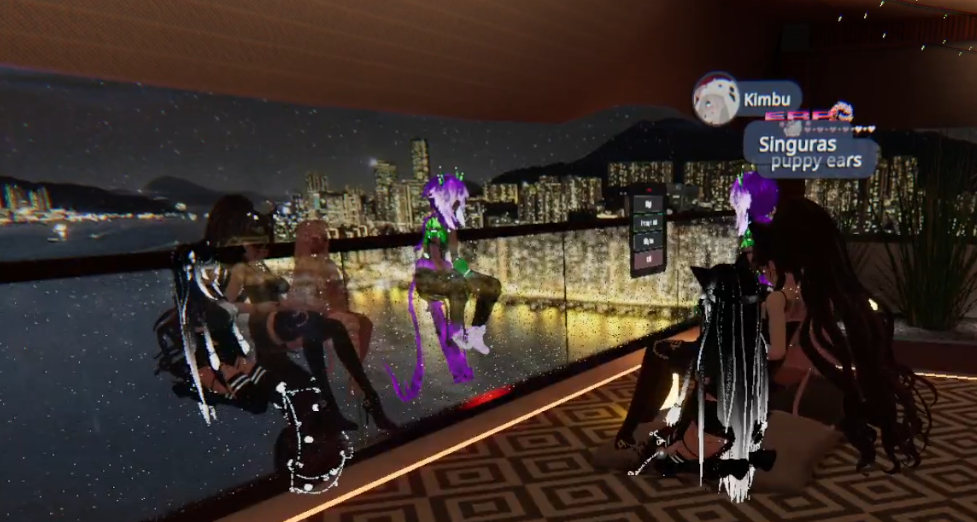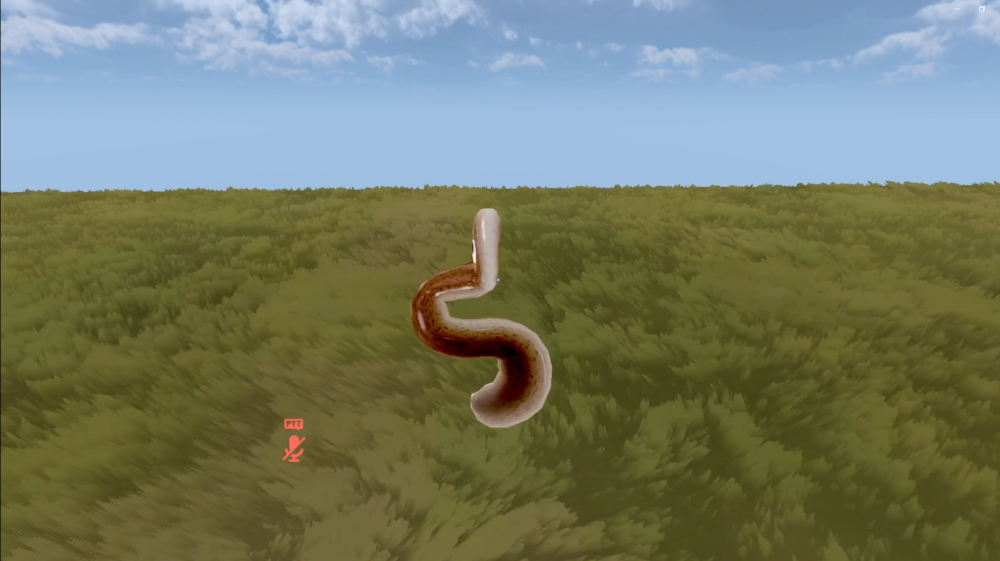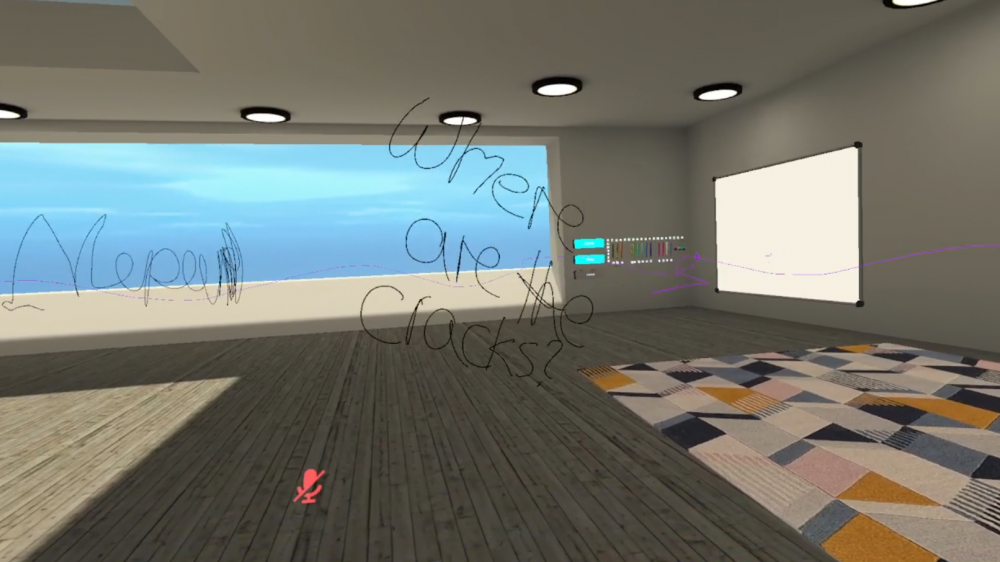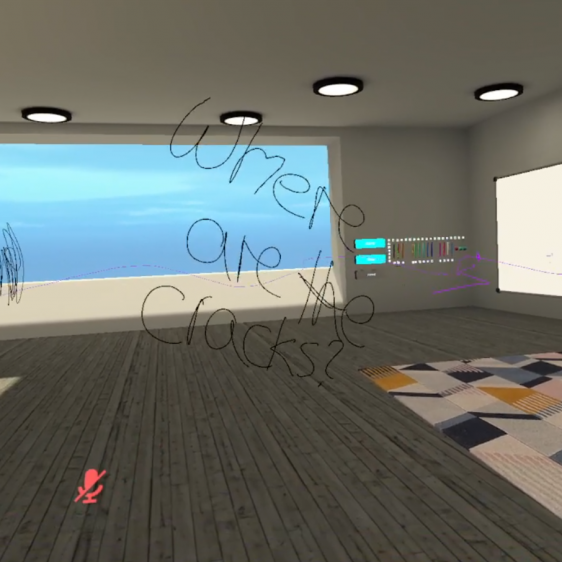Francesca Valeria Karmrodt
Francesca Valeria Karmrodt — How to meet out of now/here? (Essay)
Transmedia Spaces (Course) — Winter 2022
- Introduction
The Artistic Research of our group is based on the relationality and performativity of hybrid identities and their collective gestures of rupture as a decolonizing strategy within VRChat spaces. VRChat is an open-source technological practice of worldmaking that distinct to it’s heterogeneous appearance still reproduces analog descriptions of reality and reflects it’s origin. Colonial representations of power, labour and late capitalism are inherent to varying degrees as well as semiotics of spatial constructions that reproduce a classical spatial understanding and control of space by re-installing spatial rules into virtual worlds. It’s the uncontrollable social – the interrelating to other users - that makes the spaces alive and differs to a more capsulated experience of other VR experiences. Using Oculus Quest 2 VR Goggles to enter the VRChat App by Steam we focused on the following research questions: Through which (collective) gestures of rupture can we decolonize VRChat spaces? Which cracks can we create within the worlds and implement some Nepantla? How can this technology help to explore relational identities and their re-writing and re-imagining?
- Theoretical Background
Chicana Queer artist and theorist Gloria Anzaldúa refers to Nepantla as an imaginery borderland and liminial in-between space of living for people escaping traditional identity categories underlining both the historical and metaphorical narrative of borders. Nepantla as an alternative concept is a “place where transformations are enacted. Nepantla is a place where we can accept contradiction and paradox.” Similarly Homi K. Bhabha resolves around his concept of Third Space as a contradictionary and ambivalent hybrid space of enunciation that makes structure of meaning and reference ambivalent destroying the mirror of representation of cultural knowledge. Having strong resemblance both authors construct a theoretical figure of a dynamic space which allows alternative construction and positions that are hybrid to emerge – being neither one nor the other.
“Art and la frontera intersect in a liminal space where border people, especially artists live in a state of nepantla, in-between state, when moving from one place to another, changing class, race, sexual position, identity shifts.”
Following Anzaldúas conceptual framework identity is a performative act that dynamically changes according to the aspect of interrelating and positionality in space(s). In these continuous shifts and deconstructions “[t]o be disoriented in space is the normal way of being”. This involves challenging externalized forms and labels of social identity which are mostly based on historical, biological, or nationalist categories. Instead Anzaldúa suggests hybrid as a new category of identity which moves in a constant negotiation mode escaping binary categorization. With regards to the subject of our research being situated in the virtual world Legacy Russell makes the high potentiality of online spaces clear:
“I was a young body: Black, female-identifying, femme, queer. There was no pressing pause, no reprieve; the world around me never let me forget these identifiers. Yet online I could be whatever I wanted. And so my twelve-year-old self became sixteen, became twenty, became seventy. I aged. I died. Through this storytelling and shapeshifting, I was resurrected. I claimed my range.”
This possibility of shifting, re-writing and re-imagining identity can be converted to VR communal spaces such as VRChat. Like Anzaldúa our focus was to create cracks in (colonial) discourse and representations of VRC by using shifting identities, border crossings and hybridism as strategies for the decolonialization of spaces.
- Findings: Phenomena in VRChat
A strong phenomenon we stumbled across where the avatars sitting in front of mirrors for long period scopes of time referred to as “mirror dwellers” in VRChat jargon. They seem to represent one of the two substantial experiences users are drawn to in VRC. Observing their chosen crafted digital avatar they are engaging in a very capsuled immersive experience. By entering in VRChat they find themselves in a conversional state in-between the borderlands of realities (analog-digital) and self, immersing in a form of embodiment of their visual form of chosen identity. On the other hand VRC is used as a mode of assembling with others. Rather than engaging in strong conversations and getting to know other users it is more about sharing spaces, hanging out in a collective which gives emphasis to a form of constant noise and disorientation we stumbled up onto. When analyzing the forms of visual representation of selves which are used many avatars appear in the formal-aesthetic expression of goth animes. What is more is the conspicuous use of religious or radical right-wing political figures. We once met a user who had invested a horrendous amount of time in building a giant Nazi Warrior. When we asked him about his appearance, he made clear that it was because he “is german”. VR chat is not a „controlled“ environment, in fact some users refer to it as having a similarity to the early worldwide web. Other than a social code of conduct which is presented to the user before entering a new world there is no official surveillance for harassment of any kind. VRChat is a platform that allows people with highly radicalized tendencies to implicitly express political perspectives through the visual representation of their avatars without having to face legal consequences. Another aspect builds the implementation of analog capitalistic bound representations of western companies into VRC. When entering a world which consisted out of a McDonalds Restaurant we encountered – typically for VRC – a high percentage of kids playing. They were gathering behind the counters, taking orders and actively engaging in forms of labor for an imperialistic market player. As an open world system anyone can build worlds in VRC allowing companies to implement their analog products in the digital realm generating a marketing feedback loop which redirects back to the consumers.
- Methodology: Creating cracks, implementing Nepantla
Following Anzaldúas theory of Nepantla we searched for ways in which we could implement some Nepantla into VRChat through decolonizing gestures of rupture. First of all the four of us were always sharing one digital body when entering VRC. Often times with one person moving, another speaking, one filming, one modeling the tech – which hacked and created a glitch in the conventional user mode borders while infusing a collective identity with a multi-subjectivity into the space. As Anzaldúa put it “[w]e are both nos (us) and otras (others) – nos/otras” . In engaging with other users subtle socialized narratives inhabited the space that tried to localize the digital identity back to it’s analog geography relying on nationalist border thinking (“Where are you from?”). We deconstructed this through building geographies of selves that don’t allow a rigid trace backwards but present an assemblage of reference points blurring traditional ways of relating to identity categories. What is more the visual representation that we chose for our Avatar. Planarians are fluid moving hermaphroditic flatworms from the class of Turbellaria. In choosing a non-human form which embraces an ambivalence of having two sexes and appears in a non-binary way we disrupted conventional avatar reading patterns and created another crack. In fact very often other users commented our appearance with the words “you’re gay!”. Another mode of decolonizing VRC spaces were actions and language itself. As many worlds include free floating pencils and brushes that avatars can use in our continuous border crossing and world hopping we tagged many different spaces with Nepantla related quotes and questions. In writing small manifests and poems that we continuously shared in an iterative manner with other users we further tried to disrupt established orders. Lastly we implemented a voice altering plugin that allowed us to speak from a place of polyphony, having a multiplicity of autotune manipulated voices. This again reflects the assemblage of identities. In this way of taking agency through performative actions we explored the relationality and positionality of identity in our artistic research and experimented with the productivity of Glitches as a manner of creating cracks and decolonizing f(r)ictions in constructed VRChat realities.
We’re just in another fiction.
Why did you take on this role?
What is your code of belonging?
Are you a shape shifter?
What is it you wish to show?
Who are you? I mean really?
And how many?
Do you rely on our perspective?
We appear in space together.
These overlapping worlds.
Ever shifting.
Identity is a performance.
An act of projection. An artifice.
A fabrication. A projection.
Echo Echo Echo
We whisper from the cracks.
(Excerpt of a text)
Bibliography:
Anzaldúa, Gloria: Borderlands/La Frontera: The New Mestiza, San Francisco (Aunt Lute Books) 1987.
Bhabha, Homi K.: The Location of Culture, Abingdon (Routledge Press) 1994.
Russell, Legacy: Glitch Feminism, New York (Verso Press) 2020.





